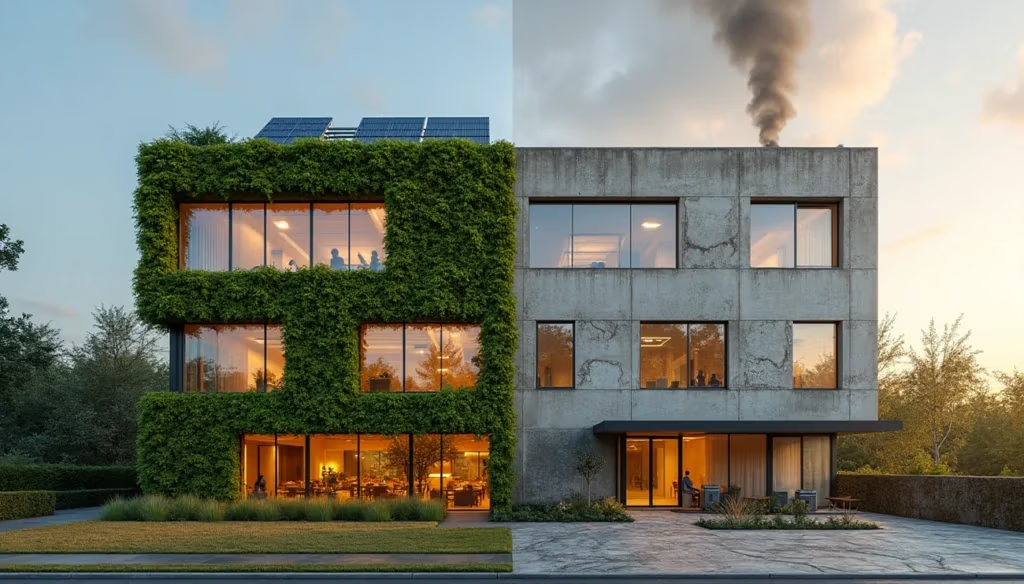
Sustainability in real estate has evolved in the last years into a financial necessity. The industry generates 40% of global carbon emissions, yet only 6% of companies call themselves leaders when it comes to measuring and reporting their properties’ environmental effects.
Commercial buildings in the United States consume 18.7% of total energy and use up 88% of drinkable water. Companies that ignore green practices in their real estate investments face substantial hidden costs. Green buildings present a $24.7 trillion investment chance by 2030. Buyers now readily pay extra for eco-friendly properties. The financial consequences of overlooking sustainability in real estate can affect your bottom line more than you might expect. This piece gets into the actual costs of neglecting sustainable real estate development and shows how these choices impact your finances in unexpected ways.
Property owners who ignore environmentally responsible development face mounting costs that go way beyond the reach and influence of environmental concerns. These costs directly affect their profits.
Buildings consume almost 40% of global energy and produce one-third of greenhouse gas emissions. Energy use stands as the biggest expense in commercial office buildings—taking up one-third of typical operating budgets. Office buildings waste up to one-third of their energy consumption, which creates a major financial drain. U.S. property owners spend more than $370 billion annually on energy.
Studies show that cutting energy use by just 10% could boost net operating income (NOI) by 1.5%. A 200,000-square-foot office building that pays $2 per square foot in energy costs could gain $40,000 in NOI. This could mean $500,000 in added asset value. Companies that run energy efficiency programs have seen their portfolio values jump by $344 million.
The costs don’t stop at energy expenses. Traditional buildings need more maintenance over time. LEED-certified buildings cost 20% less to maintain than regular commercial buildings. Buildings that modernize their green features usually cut operating costs by 10% in the first year.
Climate-related disasters pose another major risk. These events caused over $300 billion in business losses in 2022. Buildings without proper resilience planning face growing repair costs and possible structural damage from extreme weather. Insurance becomes a challenge too—Deloitte expects commercial real estate insurance premiums in high-risk U.S. areas to double by 2030.
Buildings that skip sustainability features lose their market appeal. The numbers tell the story:
Nine out of ten global institutional investors now look at sustainability when making decisions. Bloomberg predicts that global ESG assets will reach $40 trillion by 2030—making up over 25% of projected assets under management. Banks have become reluctant to finance carbon-heavy buildings, which limits options for non-sustainable properties.
Buildings with better sustainability features attract tenants easily and command higher rents and sale prices as investor and tenant priorities shift.
Climate change has altered the real estate map through physical damage to properties and major market devaluation. These climate-driven risks are different from regular market ups and downs. They represent a permanent change in property economics that will shape investment decisions for decades.

The U.S. saw 28 confirmed billion-dollar weather events in 2023. This number stands as the highest since records began in 1980. The trend looks grim—climate disasters in 2022 caused $313 billion in global economic losses. Warming oceans have doubled the number of Category 4 and 5 hurricanes since the 1970s.
The damage goes well beyond coastal areas. About 38% of California homes—4.9 million properties—sit in high-fire-threat areas. Scientists expect wildfire frequency to jump by 12-53% this century. Urban heat islands make extreme temperatures worse, which weakens building materials and cuts short their structural life.
Insurance markets have started responding drastically to these growing risks. Climate-driven weather will push homeowners’ insurance premiums up by 29.4% nationwide by 2055. Right now, homeowners in the riskiest ZIP codes pay 82% more than those in safer areas.
Getting insurance has become harder. Major insurers have pulled out completely from climate-vulnerable markets in Florida, Louisiana, and California. Sun Belt states feel this impact the most. They’ve carried over 40% of the country’s $2.8 billion natural disaster costs since 1980.
The financial figures present a striking image. Climate change will erase about $1.47 trillion in U.S. home values over the next 30 years. Recent studies reveal a $121-$237 billion overvaluation of flood-prone properties. This scenario creates a housing bubble similar to the 2008 financial crisis.
Climate risks already affect market behavior. Properties in high-risk areas sell for less now. California homes near wildfire-affected areas lost 2.2% of their value after major events. Lower-income homeowners could lose up to 10% of their property values.
These changes reach beyond individual homeowners. Property taxes make up 72% of local government revenue on average. Falling values in climate-vulnerable areas threaten essential public services and could create a downward spiral for affected communities.
Property owners face mounting financial pressure as government regulations reshape sustainability in real estate. Those who fail to adapt now deal with serious business and financial risks that go beyond climate concerns and operational expenses.
Minimum efficiency requirements have become mandatory as part of building energy codes for new construction and major renovations. These changes will affect approximately 75% of U.S. buildings by 2035. The baseline standards set by these codes directly alter long-term operating costs.
The International Energy Conservation Code (IECC) and ASHRAE 90.1 keep raising their requirements as regulatory frameworks evolve. Building Performance Standards (BPS) policies now exist in 12 jurisdictions, including New York and Washington, DC, with more cities likely to join soon.
Financial penalties hit hard when companies break compliance rules. German companies that violate sustainability laws must pay fines up to €10 million or 5% of annual revenue. French authorities can impose penalties of about $81,400 and even jail corporate leaders who violate sustainability reporting rules.
Companies with non-compliant buildings also face these challenges:
Property owners who ignore sustainable real estate development miss out on major financial benefits. Federal buildings that follow sustainability standards spend 20% less on maintenance than typical commercial properties. These maintenance savings represent just one part of the available financial advantages.
Tax incentives, grants, and funding programs have become common features of federal policies that promote sustainability trends in real estate. Buildings that fail to meet sustainability criteria cannot access these programs. This creates a growing financial divide between sustainable and conventional properties.
Property owners who neglect regulatory requirements for sustainability in real estate industry risk both penalties and losing valuable chances to offset their implementation costs through available incentives.
Property owners who ignore eco-friendly development miss out on major financial rewards in today’s market, beyond just facing risks and penalties.
Certified sustainable buildings consistently bring higher values in markets worldwide. JLL research reveals rental premiums average 7.1% in major North American cities, 9.9% throughout Asia Pacific, and 11.6% in London. Buildings with LEED certification achieve rental premiums of 25.3% to 77.5% compared to non-certified offices. BREEAM certification boosts capital values by 20.6% on average.
The green bond market grows faster than ever, with global issuance hitting $587.60 billion in 2023 – a 15.3% jump from 2022. These financial tools fund sustainable real estate projects with unique advantages. They attract more investors who want both traditional and sustainable returns. Many institutional investors now put money into sustainable finance and accept slightly lower returns to get environmental benefits—a trend called the “greenium.”
Young generations lead the push toward sustainability-driven tenant priorities. About 80% of Millennials and 75% of Gen Z say sustainability guides their buying decisions. Buildings that add sustainable features create healthier spaces where people work better and feel more satisfied. Better air quality, natural lighting, and green spaces make a difference. One Paris office saw employee well-being jump 43% and productivity rise 38% after adding wellness standards.
Research shows a huge supply-demand gap—the need for high-quality, low-carbon workspace will exceed supply by 75% across major U.S. markets by 2030. Twenty major global office markets will only meet 34% of projected future demand for low-carbon workspaces. Early sustainability investors benefit from higher occupancy levels, rental premiums, lower compliance costs, and reduced operating expenses.
Neglecting sustainability in real estate costs way beyond the reach and influence of environmental concerns. Property owners who stick to traditional approaches now face mounting challenges from multiple directions. Energy inefficiencies alone cost U.S. property owners over $370 billion annually. Green buildings show 20% lower maintenance costs and better operational savings.
Market forces now reward sustainable properties more than ever. Green buildings earn premium rental rates between 7% and 11% in major global markets. These buildings attract both tenants and investors looking for ESG-lined up opportunities. Climate-related risks could wipe out $1.47 trillion in U.S. home values over the next three decades. This creates an urgent push for better resilience planning.
Of course, regulatory pressures add more complexity to the situation. Building codes keep evolving, and compliance requirements get stricter. You must adapt or face heavy penalties. The choice is simple: either pay growing costs with falling property values or adopt green practices that give you competitive advantages.
Sustainability helps you manage risks and creates new chances. Buildings that meet these evolving standards avoid penalties. They also get access to the faster-growing green bond market and tax incentives. The widening gap between supply and demand for sustainable spaces gives you a great way to separate your properties in this competitive market.
Moving toward sustainable real estate needs upfront investment. However, it pays off through lower operating costs, higher occupancy rates, and better property values. Your sustainability choices today will impact your real estate portfolio’s financial performance for decades. The hidden costs of doing nothing are too big to ignore. Green development shows a clear path to long-term profits and resilience.
Ignoring sustainability in real estate carries massive hidden costs that directly impact your bottom line, from skyrocketing energy bills to regulatory penalties and missed market opportunities.
• Energy waste costs $370 billion annually. Buildings consume 40% of global energy, with office buildings wasting one-third of their consumption, making efficiency improvements critical for profitability.
• Climate risks threaten $1.47 trillion in property values—Extreme weather events and rising insurance premiums are already devaluing properties, with high-risk areas facing coverage withdrawal.
• Green buildings command 7-11% rental premiums globally – Sustainable properties attract higher rents, lower maintenance costs, and preferential access to ESG-aligned capital markets.
• Regulatory compliance is becoming mandatory – New building codes and energy standards affect 75% of U.S. buildings by 2035, with non-compliance resulting in substantial fines and market exclusion.
• Supply-demand gap creates competitive advantage—Demand for sustainable workspace will outstrip supply by 75% by 2030, positioning early adopters for significant market advantages.
The transition to sustainable real estate requires upfront investment but delivers substantial returns through reduced operating costs, higher occupancy rates, and increased property values. The financial case for sustainability has never been stronger.